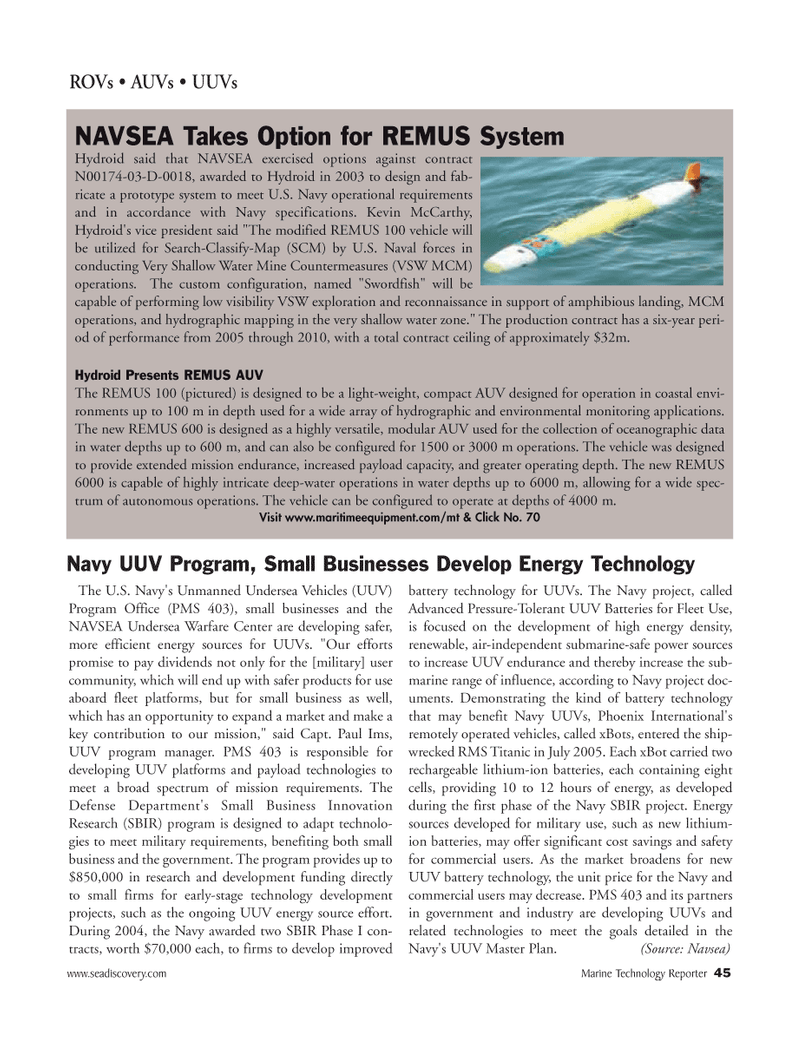
Page 43: of Marine Technology Magazine (March 2006)
AUVs; ROVs; UUVs
Read this page in Pdf, Flash or Html5 edition of March 2006 Marine Technology Magazine
www.seadiscovery.com Marine Technology Reporter 45
The U.S. Navy's Unmanned Undersea Vehicles (UUV)
Program Office (PMS 403), small businesses and the
NAVSEA Undersea Warfare Center are developing safer, more efficient energy sources for UUVs. "Our efforts promise to pay dividends not only for the [military] user community, which will end up with safer products for use aboard fleet platforms, but for small business as well, which has an opportunity to expand a market and make a key contribution to our mission," said Capt. Paul Ims,
UUV program manager. PMS 403 is responsible for developing UUV platforms and payload technologies to meet a broad spectrum of mission requirements. The
Defense Department's Small Business Innovation
Research (SBIR) program is designed to adapt technolo- gies to meet military requirements, benefiting both small business and the government. The program provides up to $850,000 in research and development funding directly to small firms for early-stage technology development projects, such as the ongoing UUV energy source effort.
During 2004, the Navy awarded two SBIR Phase I con- tracts, worth $70,000 each, to firms to develop improved battery technology for UUVs. The Navy project, called
Advanced Pressure-Tolerant UUV Batteries for Fleet Use, is focused on the development of high energy density, renewable, air-independent submarine-safe power sources to increase UUV endurance and thereby increase the sub- marine range of influence, according to Navy project doc- uments. Demonstrating the kind of battery technology that may benefit Navy UUVs, Phoenix International's remotely operated vehicles, called xBots, entered the ship- wrecked RMS Titanic in July 2005. Each xBot carried two rechargeable lithium-ion batteries, each containing eight cells, providing 10 to 12 hours of energy, as developed during the first phase of the Navy SBIR project. Energy sources developed for military use, such as new lithium- ion batteries, may offer significant cost savings and safety for commercial users. As the market broadens for new
UUV battery technology, the unit price for the Navy and commercial users may decrease. PMS 403 and its partners in government and industry are developing UUVs and related technologies to meet the goals detailed in the
Navy's UUV Master Plan. (Source: Navsea)
ROVs • AUVs UUVs
NAVSEA Takes Option for REMUS System
Hydroid said that NAVSEA exercised options against contract
N00174-03-D-0018, awarded to Hydroid in 2003 to design and fab- ricate a prototype system to meet U.S. Navy operational requirements and in accordance with Navy specifications. Kevin McCarthy,
Hydroid's vice president said "The modified REMUS 100 vehicle will be utilized for Search-Classify-Map (SCM) by U.S. Naval forces in conducting Very Shallow Water Mine Countermeasures (VSW MCM) operations. The custom configuration, named "Swordfish" will be capable of performing low visibility VSW exploration and reconnaissance in support of amphibious landing, MCM operations, and hydrographic mapping in the very shallow water zone." The production contract has a six-year peri- od of performance from 2005 through 2010, with a total contract ceiling of approximately $32m.
Hydroid Presents REMUS AUV
The REMUS 100 (pictured) is designed to be a light-weight, compact AUV designed for operation in coastal envi- ronments up to 100 m in depth used for a wide array of hydrographic and environmental monitoring applications.
The new REMUS 600 is designed as a highly versatile, modular AUV used for the collection of oceanographic data in water depths up to 600 m, and can also be configured for 1500 or 3000 m operations. The vehicle was designed to provide extended mission endurance, increased payload capacity, and greater operating depth. The new REMUS 6000 is capable of highly intricate deep-water operations in water depths up to 6000 m, allowing for a wide spec- trum of autonomous operations. The vehicle can be configured to operate at depths of 4000 m.
Visit www.maritimeequipment.com/mt & Click No. 70
Navy UUV Program, Small Businesses Develop Energy Technology
MTR#2 (33-48).qxd 2/23/2006 4:39 PM Page 45

 42
42

 44
44
